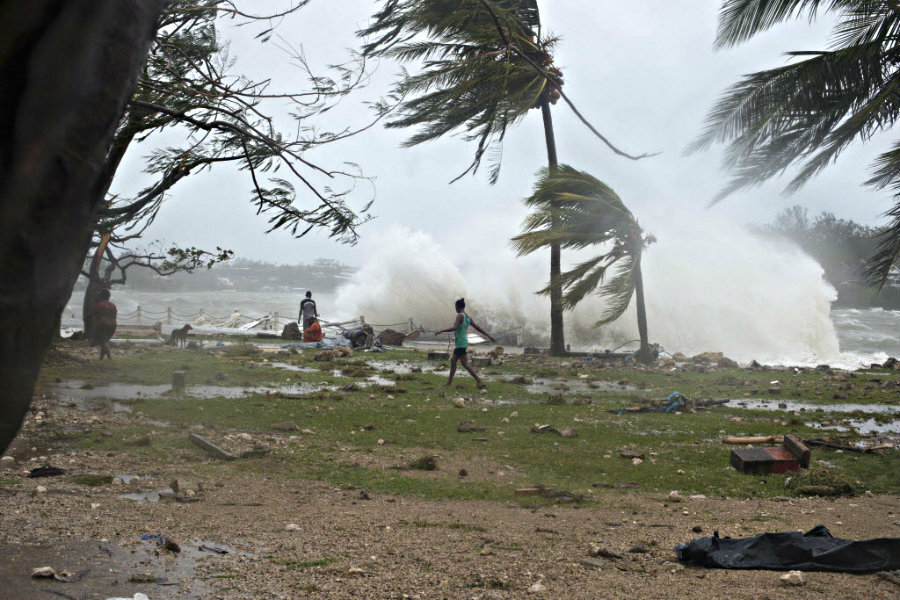Cyclone Pam and climate change: Are the Pacific Islands ready?
Loading...
At least eight people have been killed after one of the most powerful cyclones to hit the Pacific Ocean tore through the islands of Vanuatu early Saturday, multiple news outlets reported.
Packing winds up to 270 kilometers (168 miles) per hour, Cyclone Pam blew down or destroyed homes and cut off power, water, and communication lines, especially on the archipelago’s outer islands, The Associated Press reported.
As of Saturday, eight have been reported dead, but aid workers have said it could take weeks before the storm’s impact is fully evaluated.
"It felt like the world was going to end," Alice Clements, a spokeswoman for the United Nations Children’s Fund, told Reuters from Vanuatu. “It's like a bomb has gone off in the center of the town.”
Scientists have said it’s nearly impossible to attribute any single weather event to climate change, according to The Associated Press. Still, the Category 5 cyclone – the worst to hit the archipelago since Cyclone Uma left 5,000 people homeless and one man dead in 1987 – has once more raised concerns about the readiness of Pacific island nations to respond to severe weather events exacerbated by rising temperatures and sea levels.
Fighting for survival
The Pacific region has been one of the areas most affected by changes in global temperatures in recent years. In 2013, countries in the Pacific Basin recorded the highest increases in sea levels in the world, according to a report by The Christian Science Monitor, based on data from the National Oceanic and Atmospheric Administration.
Last September, the president of the Marshall Islands, a tiny archipelago near the equator, called on world leaders to act on climate change as the country’s atolls become increasingly unlivable due to rising seas, severe floods, sudden storms, and droughts, The Guardian reported.
“The Pacific is fighting for its survival,” President Christopher Loek said. “Climate change has already arrived."
Countries in and around the Pacific, including China, Japan, Vietnam, Thailand, the Philippines, and Australia, have also experienced the most tropical cyclone strikes since 1970, the same Monitor report found.
Of the five typhoons to affect the most number of people in the Philippines, four occurred within the last 10 years, according to Philippine news outlet Rappler. The worst was also the most recent: Typhoon Haiyan, which struck the archipelago in late 2013, affected more than 16 million people, including 6,000 dead. The estimated cost of damage was about $2 billion, Rappler reported.
In June, the United Nations Environment Programme warned that the effects of rising sea levels could cost the international economy nearly $12 trillion, with small island nations bearing the brunt of the impact. Later that year, the UN Economic and Social Commission for Asia and the Pacific released an El Nino advisory, predicting irregular rainfall and severe weather events across the Pacific region for 2015.
The commission recommended establishing a regional system that would help disseminate proactive climate information and strengthen early-warning mechanisms.
Unified response
Local and regional partnerships have been vital in efforts towards preventing and preparing for natural disasters. In the South Pacific island nation of Samoa, for instance, architects and environmental experts have been working with local communities to design shelters that could hold up to 200 people for three weeks in the event of a disaster.
People in Samoa “have to live with [major storms] and [previously] they built their houses accordingly, so we need to learn from the past and offer new solutions to improve things for the future,” Samoan architecture graduate Carinnya Feaunati told the Thomson Reuters Foundation.
In February, mayors and municipal leaders from the Asia Pacific region met to discuss a more coordinated response to the effects of climate change. The resulting report called for community engagement, innovation, and local and global partnerships that would help prevent and manage risk.
“There is a need to do things differently; to be prepared; to innovate; to constantly learn and adapt; and to enact the full spectrum of resilience actions, including disaster prevention, preparedness, response and recovery, for current and projected risks,” the leaders said in a statement.
That same spirit of cooperation appears to emerging as Vanuatu begins to assess what it will take to recover from Cyclone Pam's devastation.
On Saturday, Vanuatu’s president appealed to the international community for aid, the BBC reported. In response, New Zealand pledged 1 million New Zealand dollars ($734,000) towards relief efforts, and Australian Foreign Minister Julie Bishop has said Australia will send a crisis response team to Vanuatu if necessary, according to The Associated Press.
“There are destructive winds, rain, flooding, landslides, sea surges and very rough seas and the storm is exceedingly destructive there," Ms. Bishop said. “We are still assessing the situation, but we stand ready to assist."








